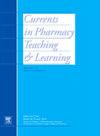Assessment of student well-being and identification of associated factors
IF 1.3
Q3 EDUCATION, SCIENTIFIC DISCIPLINES
引用次数: 0
Abstract
Objective
The current study assessed the well-being of PharmD students in the first through third professional years (PY) utilizing an internally developed survey.
Methods
A survey was administered in Spring 2022 to students at one school, which contained five-point Likert scale items measuring factors of well-being (life balance, connectivity, inclusivity, and faculty support), in addition to background variables and an open-ended item asking what program changes would improve students' well-being. Descriptive statistics were examined along with ordinary least squares regression models with PY, gender, ethnicity, and residency (local versus non-local) examined as predictors. Open-ended responses were coded using a thematic analysis approach.
Results
A total of 253 (75 % response rate) students completed the survey. The summation of, “life balance” items had the lowest mean (M = 2.84, SD = 0.77) and, “inclusivity” items (M = 3.60, SD = 0.88) had the highest mean. PY2 and PY3 students both had higher scores on the life balance items, PY2 students had higher scores on the faculty support items. Females had lower scores on the life balance items. Blacks/Hispanics had lower scores on items pertaining to inclusivity and connectivity. Students commented that improving faculty-student engagement, the scheduling or frequency of exams, and improving student-student engagement could improve well-being.
Conclusion
It is important to develop a methodical plan to assess and address student well-being. This study assessed multiple factors of well-being and found differences based on professional year, gender, and race/ethnicity. Based on the results of the study, relevant changes were made at our institution.
学生幸福感评估及相关因素的识别。
目的:本研究利用一项内部开发的调查评估了药学博士学生在第一至第三专业年(PY)的幸福感。方法:在2022年春季对一所学校的学生进行了一项调查,该调查包含五点李克特量表项目,测量幸福感因素(生活平衡、连通性、包容性和教师支持),此外还有背景变量和一个开放式项目,询问哪些项目改变会改善学生的幸福感。描述性统计与普通最小二乘回归模型一起进行了检验,其中PY、性别、种族和居住地(本地与非本地)作为预测因素进行了检验。使用主题分析方法对开放式答复进行编码。结果:共有253名学生(75%的回复率)完成调查。“生活平衡”项目的平均值最低(M = 2.84, SD = 0.77),“包容性”项目的平均值最高(M = 3.60, SD = 0.88)。PY2和PY3学生在生活平衡项目上得分较高,PY2学生在教师支持项目上得分较高。女性在生活平衡项目上得分较低。黑人/西班牙裔在包容性和连通性方面得分较低。学生们评论说,提高教师与学生之间的参与度、考试的安排或频率,以及提高学生与学生之间的参与度,可以提高幸福感。结论:制定一个有条理的计划来评估和解决学生的幸福感是很重要的。这项研究评估了幸福感的多个因素,并发现了基于职业年限、性别和种族/民族的差异。根据研究结果,我们机构做出了相关的改变。
本文章由计算机程序翻译,如有差异,请以英文原文为准。
求助全文
约1分钟内获得全文
求助全文
来源期刊

Currents in Pharmacy Teaching and Learning
EDUCATION, SCIENTIFIC DISCIPLINES-
CiteScore
2.10
自引率
16.70%
发文量
192
 求助内容:
求助内容: 应助结果提醒方式:
应助结果提醒方式:


